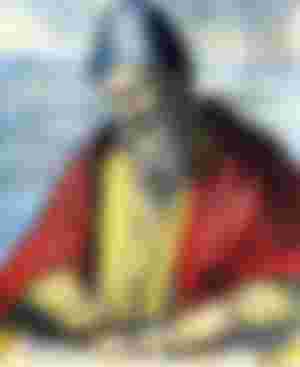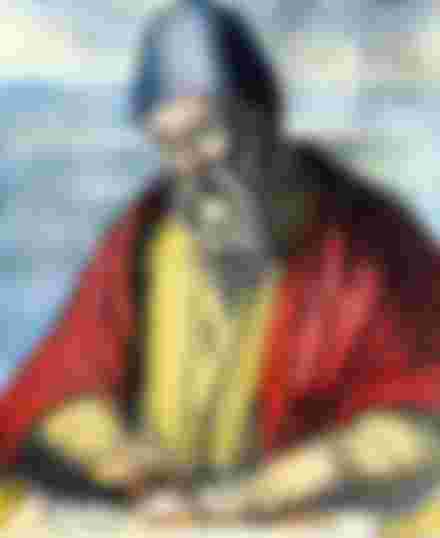Euclid (330-275BC)
Euclid of Alexandria (lived around 300 BC) organized Ancient Greek and Near Eastern mathematics and geometry. He wrote The Elements, the most widely used mathematics and geometry textbook in history. Older books sometimes confuse him with Euclid of Megara. Modern economics is referred to as a series of footnotes to Adam Smith, author of The Wealth of Nations (1776 AD). Similarly, much of Western mathematics consists of a series of footnotes that either develop or test Euclid's ideas.

Euclid's Life
Almost nothing is known about Euclid's life. He ran his own school in Alexandria, Egypt, around 300 BC. We do not know the places or the years when he was born and died. Euclid seems to have written a dozen or so books, many of which are now lost.
The Athenian philosopher Proclus (412-485 AD), who lived seven hundred years after Euclid, provides undeniable proofs of what Euclid "assembled the Elements, collected many of Eudoxus' theorems, perfected many of Theaetetus's, and cursorily proved by his predecessors." states "bring it". The scholar Stobaeus lived at roughly the same time as Proclus. Stobaeus collected Greek manuscripts that were in danger of being lost. He tells a story about Euclid that seems to be true.
Someone who started studying geometry said to Euclid, 'These
What can I gain by learning?' he asked. Euclid
He called his slave and said to him, 'Give him some money.
give, because he has to derive something from what he has learned.'
(Health, 1981, loc.8625)
Pre-Euclidean Geometry
In his Elements, Euclid collected, organized, and proved the ideas of geometry that were already being used as applied techniques. Except for some Greek precursors such as Euclid and Thales (624-548 BC), Hippocrates (470-410 BC), Theaetetus (417-369 BC), Eudoxus (408-355 BC), hardly anyone knows why ideas are true or whether they apply to the general public. Didn't try to solve it. Thales even became famous in Egypt for seeing the mathematical principles behind the rules of some particular problems and then applying those principles to other problems, such as determining the length of pyramids.
The ancient Egyptians had a serious knowledge of geometry, but this knowledge consisted of applied methods based on testing and experience. For example, to calculate the area of a circle, they made a square whose length is eight divided by nine of the diameter of the circle. The area of this square was close enough to the area of the circle that they could not detect a difference. Their method took the value of pi as 3.16, a bit far from the true value of 3.14... but close enough for simple engineering. Much of what we know about ancient Egyptian mathematics comes from the Rhind papyrus, which was discovered in the mid-19th century and is now kept in the British Museum.
The ancient Babylonians also knew a lot about applied mathematics, including the Pythagorean theorem. During archaeological excavations at Nineveh, clay tablets with triple numbers of 3-4-5, 5-12-13 and relatively larger numbers conforming to the Pythagorean theorem were discovered. As of 2006, about 960 tablets have been deciphered.
elements
Euclid was not the first to come up with many of the ideas in The Elements. His contributions were fourfold:
He collected important mathematical and geometric information in a single book. Elements was a textbook rather than a reference book, so it does not contain everything that is known.
Euclid; He gave definitions, postulates and axioms. He called the axioms "common ideas".
He presented geometry as an axiomatic system: every statement was either an axiom, a postulate, or a statement proved by clear logical steps from axioms and postulates.
He presented his own original discoveries, such as presenting the first known proof of the infinite number of prime numbers.
Elements consists of 13 subsections divided into 3 main sections: (often each section is called a "book").
Chapter 1-6: Plane geometry
Chapter 7-10: Arithmetic and number theory
Chapter 11-13: Solid geometry
Each chapter begins with definitions. Part 1 specifically includes postulates and "consensus" (axioms). Examples are:
Definition: "A point is something that has no parts."
Postulate: "To draw a straight line from any point to any other point" (This is Euclid's way of saying that a straight line exists.)
Common sense: "Things that are equal to the same thing are also equal to each other."
If the ideas seem obvious, here's what needs to be done. He wanted to build Euclidean geometry on ideas so clear that no one could logically doubt it. From his definitions, postulates, and common ideas, Euclid deduces the rest of geometry. Its geometry defines the normal space we see around us. Modern 'non-Euclidean' geometry describes space at near-light speeds or astronomical distances bent by gravity.
